Updated in 2023 to explore some more J-hook options and adapters.
Table of Contents
The Dark Ages
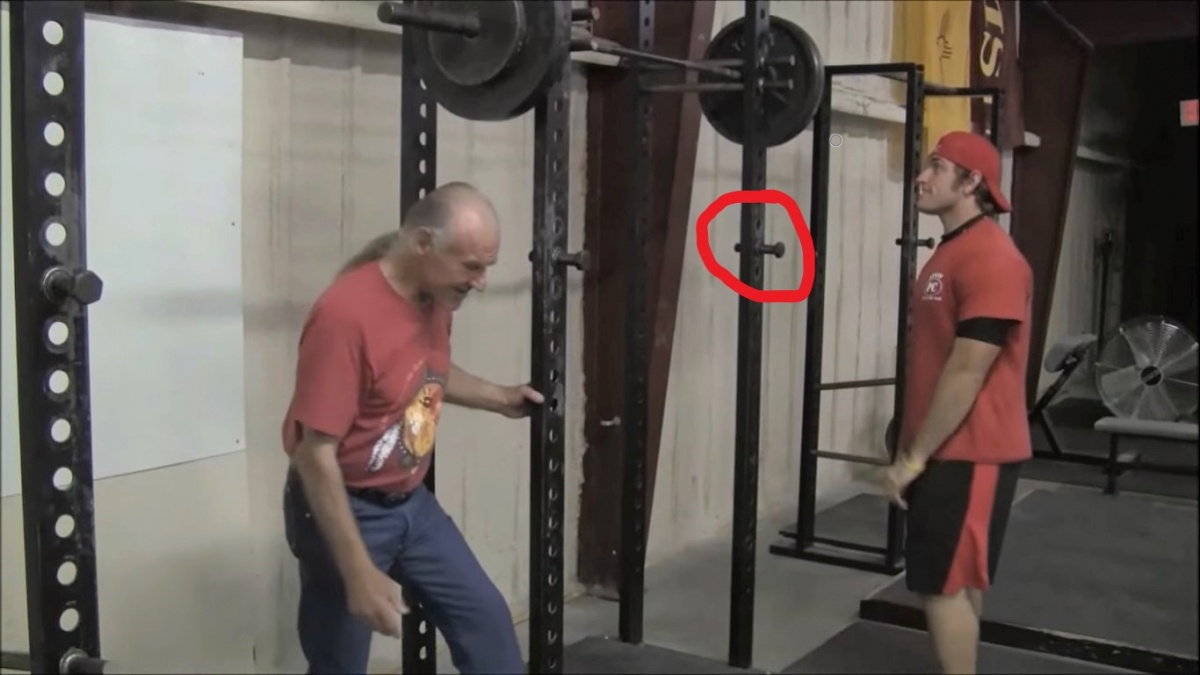
source: https://youtu.be/jMhrxet9Cgc
In early power racks you would see a pair of modified bolts going through the rack and sticking out to hold the bar.
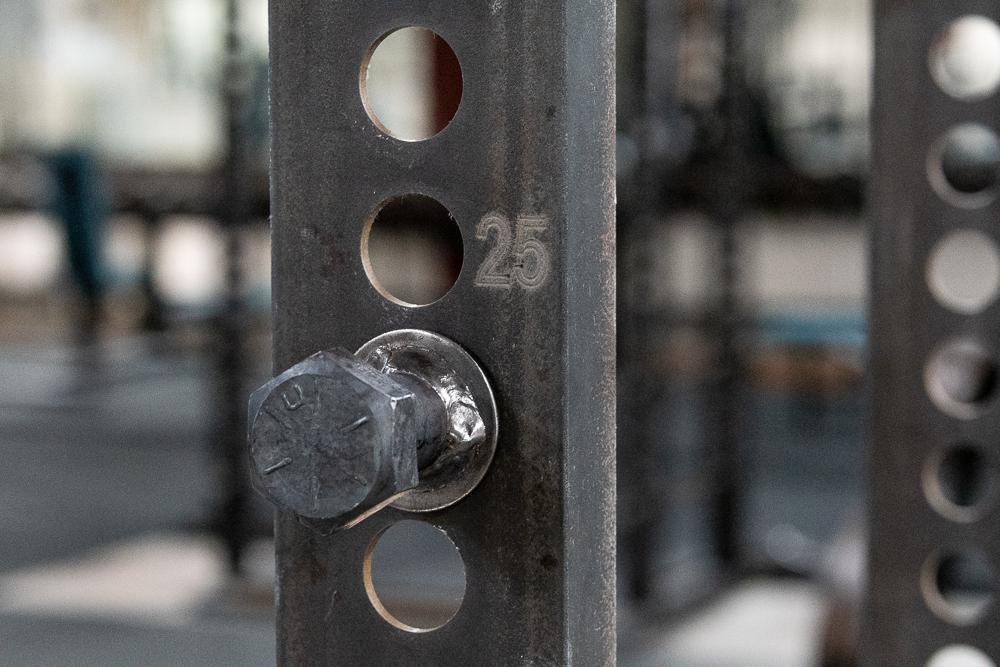
What appears to be those same York bolts are still made as bar holders for the throwback Starting Strength Power Rack above.
The bolt crushes your bar knurling with its very small contact area against the bar. Back in the day, the overwhelming majority of bars in home gyms were cheap and not worth protecting. Now that people are paying more attention to the quality of bars, and the price has come down on them to make them accessible to more people, protecting the bar knurling has become a higher priority.
All-Steel J-Hooks
More engineering was put into the shape of these than the earlier pin designs.
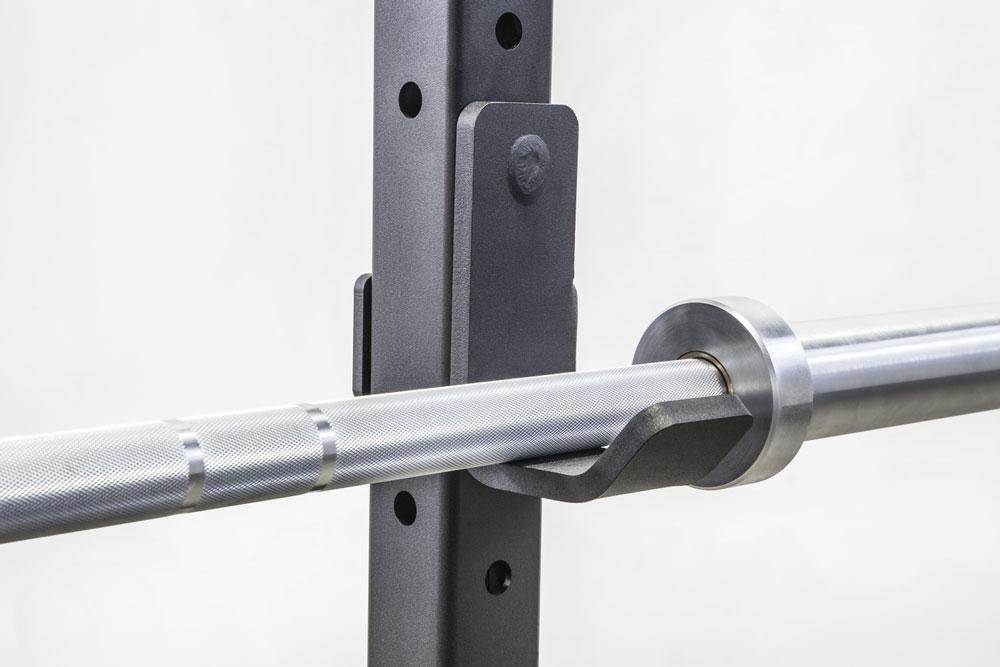
These have become hard to find too, in favor of the ones in the next section. They are made with a C-channel bracket for a flip-down design, like most rack attachments now.
Note that Rogue and some others call them J-cups, while others call them J-hooks. Same exact thing.
A J-hook has a wider contact area against your bar than a round peg. This leads to less severe pounding-in of the knurling, but it also leads to scratches over a larger area, shaving off the knurling. All in all, I don’t think it’s a whole lot better in this respect. Steel-on-steel is never a a good thing for durability.
Notably, they do have a backplate for you to walk the bar in to rack it against, from which the bar can fall straight down into the hook without catching on anything, unlike the bolt design further above where it can catch and freak you out.
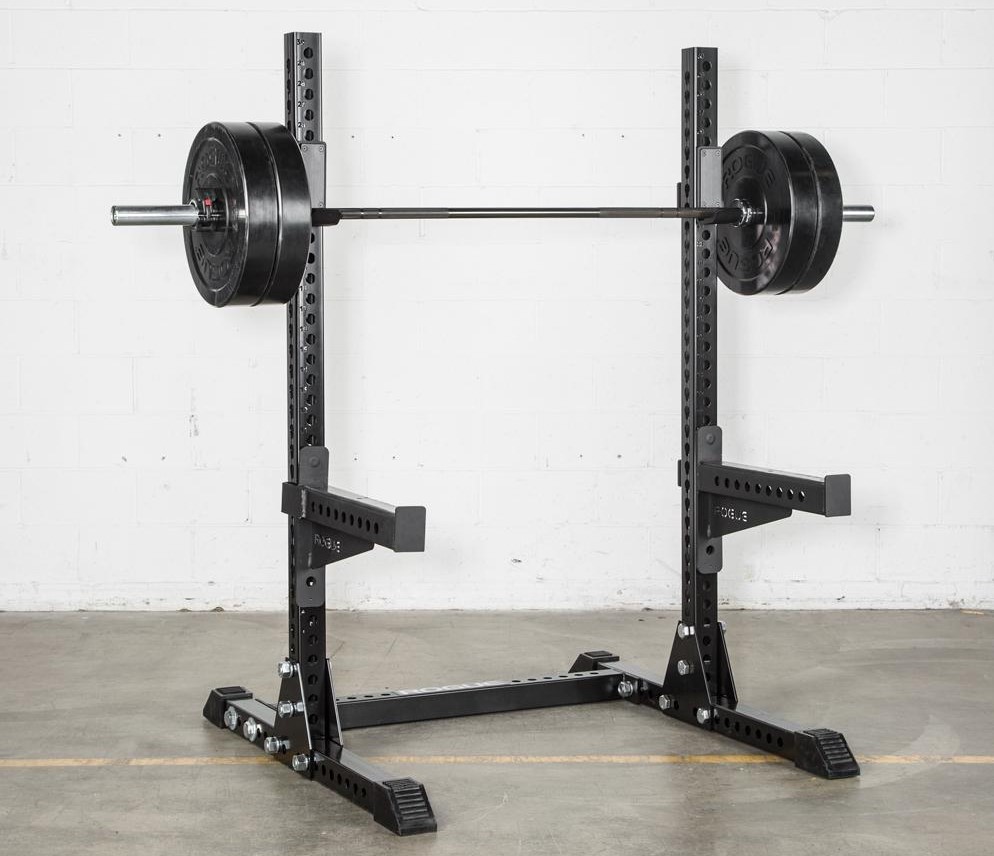
There is one possible disadvantage to J-hooks vs the simple bolts that the above pic illustrates. A bolt holds the bar at the same height you stick the bolt through. The J-hook holds the bar several inches lower. If you happen to be well over 6ft tall and you’re using a shorter squat rack like the Rogue SML-1, you could run into a problem with the max bar height.
UHMW Plastic Lined J-Hooks
Now we’re into current technology. This was a much-needed upgrade over all-steel J-hooks. The inside of the J-hooks have UHMW (ultra high molecular weight) plastic liners to protect your bar’s knurling and reduce noise.
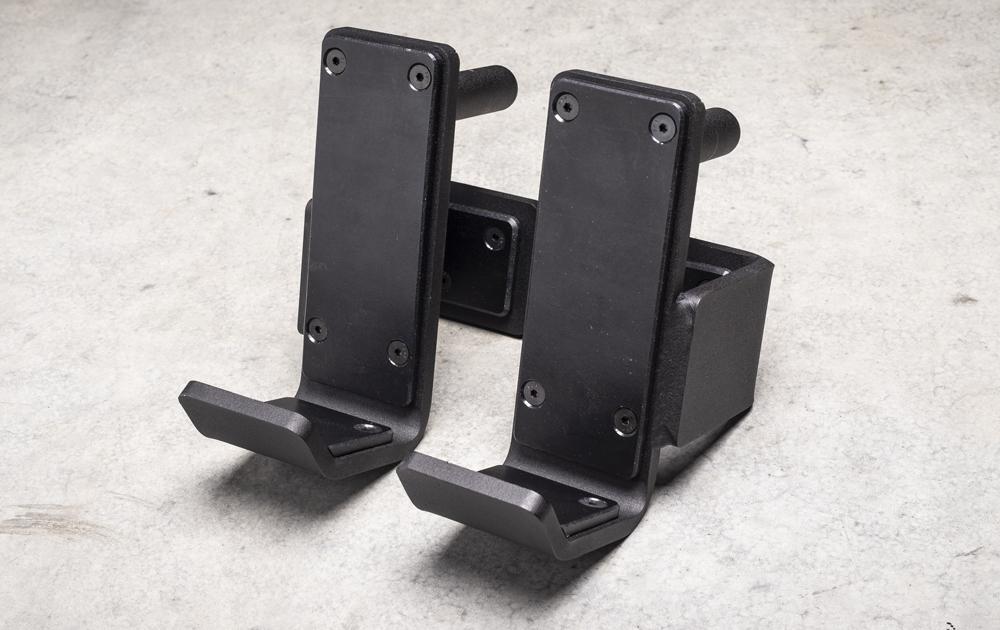
This type of plastic is hard and durable and has withstood the test of time in this application. It will not crack, even with a loaded bar slammed down onto it.
Normally the wear against the plastic, or against all-steel J-hooks for that matter, comes from you rotating the loaded bar as you try to slide it back centered after racking it, digging the knurling into the surface. Other normal use just doesn’t wear the plastic at all.
The proper term in industrial applications for this material is UHMWPE, ultra high molecular weight polyethylene. In the gym equipment industry it has gotten shortened to UHMW, or UHMW plastic. There are others such as HDPE, high density polyethylene. UHMWPE is the strongest.
As you can see in the pic of Rogue’s above, the back inside of the C-channel has a UHMW plastic liner as well, to protect the rack and reduce clanging noise.
However, check out this problem…
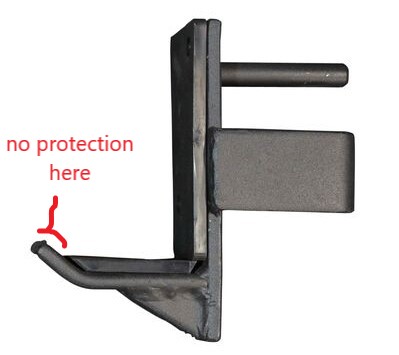
Most UHMW lined J-hooks, including Rogue, do not protect the front lip of the cup. So if your bar rolls forward to the lip, which is normally where you want it for unracking, then you’re scratching up your bar. There’s room to line the lip too. They choose not to do it to save on costs.
FringeSport, Bells of Steel, and Valor Fitness are three companies who pad the inner lip of their J-hooks, or at least on some models.
Update: Cary in the comments below brought Aperture Engineering’s J-hook liners to my attention to address this issue. I subsequently reviewed a pair.
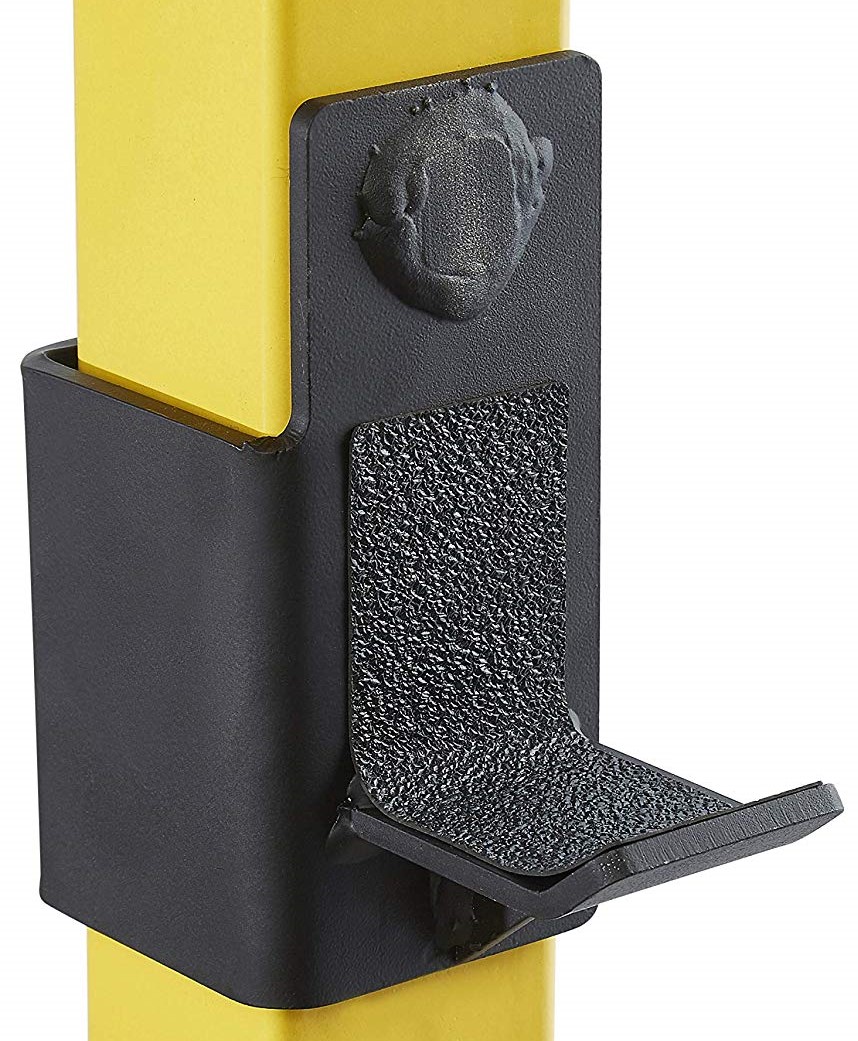
Warning: Some J-hooks are “upgraded” with a strip of some thin protective tape like the above, which is trash and will wear out quickly. In one diagram, they say this tape is only meant for protection during shipping, which is nonsense because of where it’s placed, and the way all their pictures include it.
Premium Option 1: Sandwich J-Hooks
What are these “sandwich” J-hooks, why are they more expensive, and why does anyone want them?
That’s what I thought when I first ran into them online. What’s wrong with other J-hooks? Well, I’ll tell you.
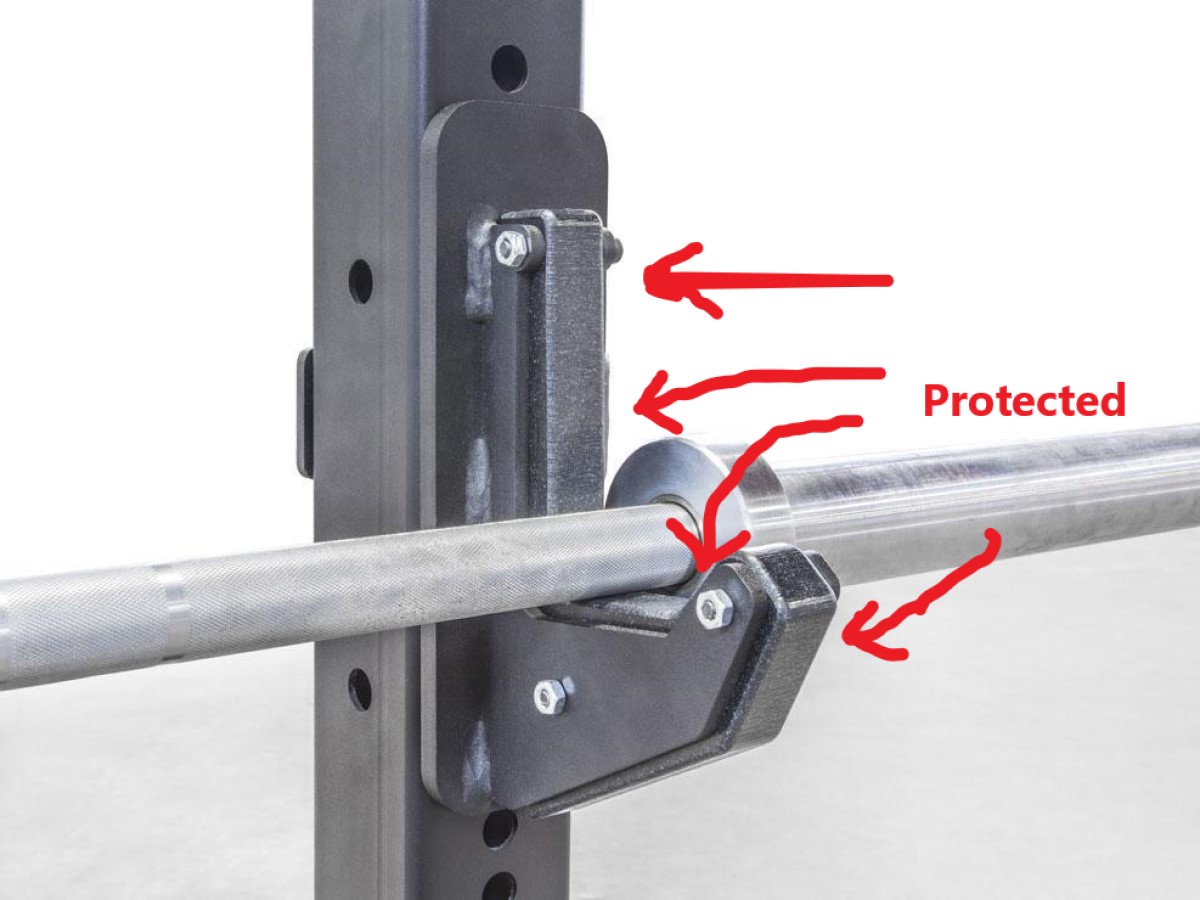
A thick chunk of UHMW plastic is sandwiched and bolted in between two thick steel plates in a way where the plastic sticks out all over. This design has a couple major advantages.
First, if you re-rack too low, into the bottom front of the J-hook, you’re still only hitting the plastic, not steel like you would with regular J-hook that only have plastic liners on the inside of the hook. It’s also so tall that if you rack the bar a few inches too high you’re still on the J-hook.
Second, the thin design of sandwich J-hook (it’s only 1.5″ thick side-to-side) gives you more room for side-to-side slop when racking the bar. That puts you at far less risk of hitting the shoulder of the bar on the J-hook as you rack the bar and trying to glance to your side to see what’s going on. You gain on an inch or two of room on both sides. The hook protrudes far enough from the rack that the bar shoulder will not hit the rack’s steel upright.
While your bar is the main thing to make sure you like in your gym, because it’s the thing you’re directly handling, the J-hooks of a rack are perhaps the next thing, because they control how easy it is for the bar to interact with the rack.
Several manufacturers make these. Rep Fitness makes good ones that are 100% compatible with Rogue racks at less than half the price of Rogue. Specifically, Rep’s PR-4000 sandwich J-cups fit Monster Lite racks, while their PR-5000 sandwich J-cups (select them on the same page) fit Monster racks. Normally Rep’s pricing is closer to Rogue, as their quality is about the same, but in this case it’s a steal.
Rep also makes rounded sandwich J-hooks. They give the advantage of the bar being always racked evenly front to back on both hooks, though not necessarily even laterally (see the roller J hooks section below for a solution to that). The disadvantage is you have to clear more of the J-hook, both vertically and horizontally, when lifting off, and I personally would find that too annoying.
Other brands have lousy cross-brand compatibility. They need to fit right. See the power rack accessories and compatibility guide.
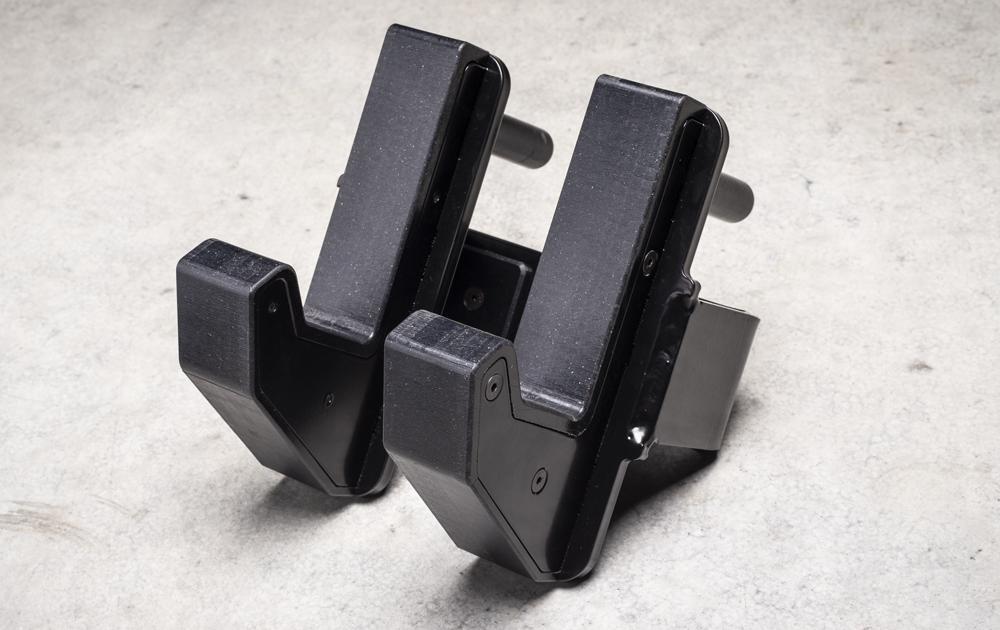
Rogue makes some extra-wide 2″ sandwich J cups for their Monster racks, which are made with the hardware recessed into the design so that no bolts are sticking out, for a cleaner look and no potential of the shoulder of your bar hitting a bolt.
Premium Option 2: Roller J-Hooks
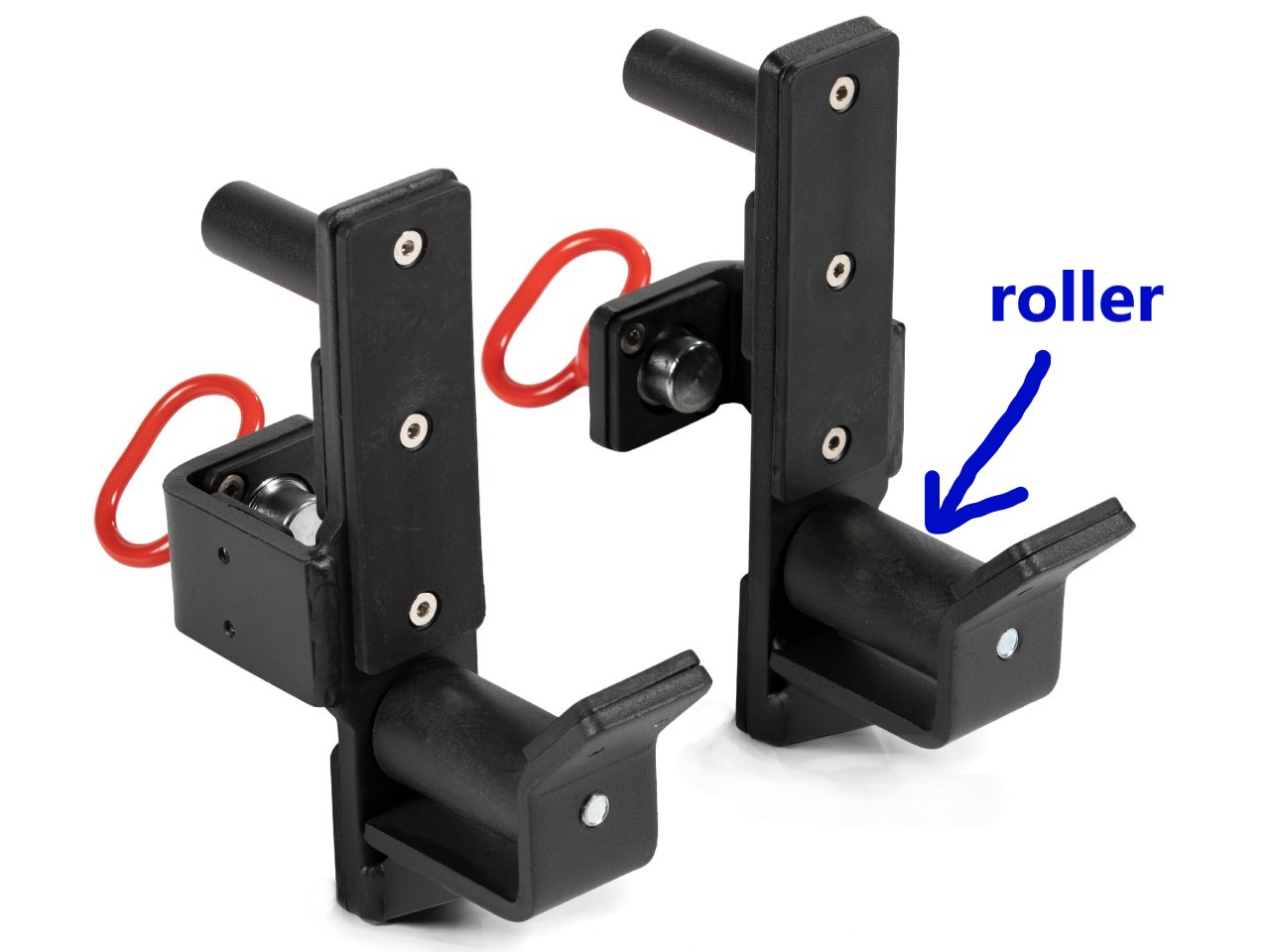
With roller J-hooks, re-centering the bar before each set becomes trivial with the nylon roller that is set over a steel pin. Normally it’s an onerous task if you have a lot of weight on the bar. I imagine the idea has been around for a while. I saw a clip of Alan Thrall some time back building some steel ones into his olympic bench before I found any of these for sale.
The above are from Titan Fitness, who currently has them in 4 sizes to fit each of their rack series, which makes them compatible with the majority of other brands of racks. Titan’s racks are metric sized at 75mm square tubing, but these should fit over imperial 3″x3″ tubing too. The issue you’ll run into is their hole spacing is also metric and the locking pin might not line up on your rack.
Basement Brandon pointed out in the below video that roller J-hooks must be prevented from swinging sideways, due to the lateral force you apply to roll the bar. So they either need to fit snugly enough that the roller functions before the whole attachment swings or the attachments need a locking pin like Titan’s above.
Some rollers are tapered, not straight like Titan, forcing the bar into one spot – a lot like rounded sandwich J-cups do as mentioned in a section further above – and making re-racking possibly unnerving.
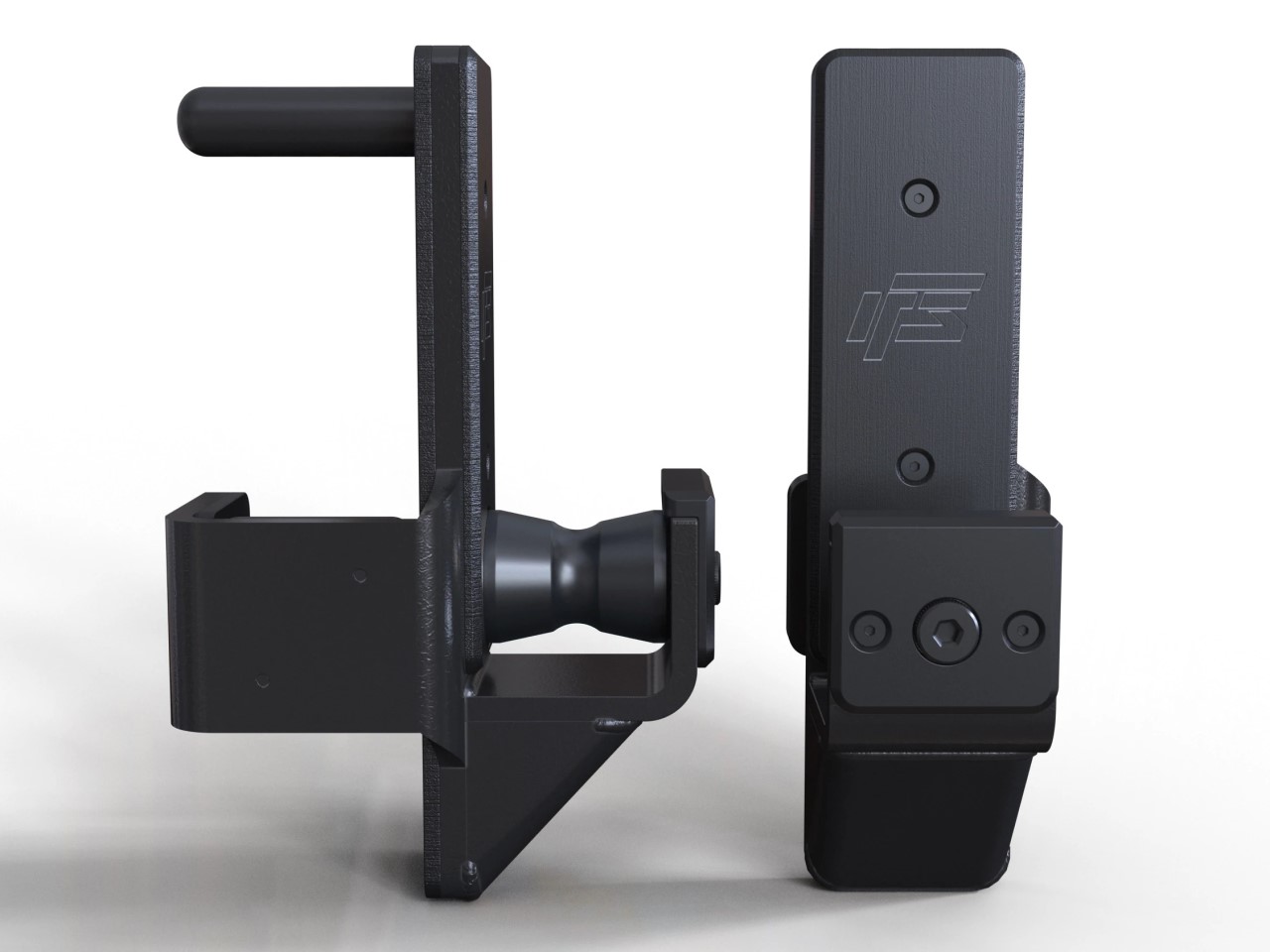
Although I normally focus on US-based companies, Irwin Fitness, shipping out of Canada, is one other company that will make them with flat rollers as an option above, and they reportedly fit perfectly snug on true 3″x3″ tubing.
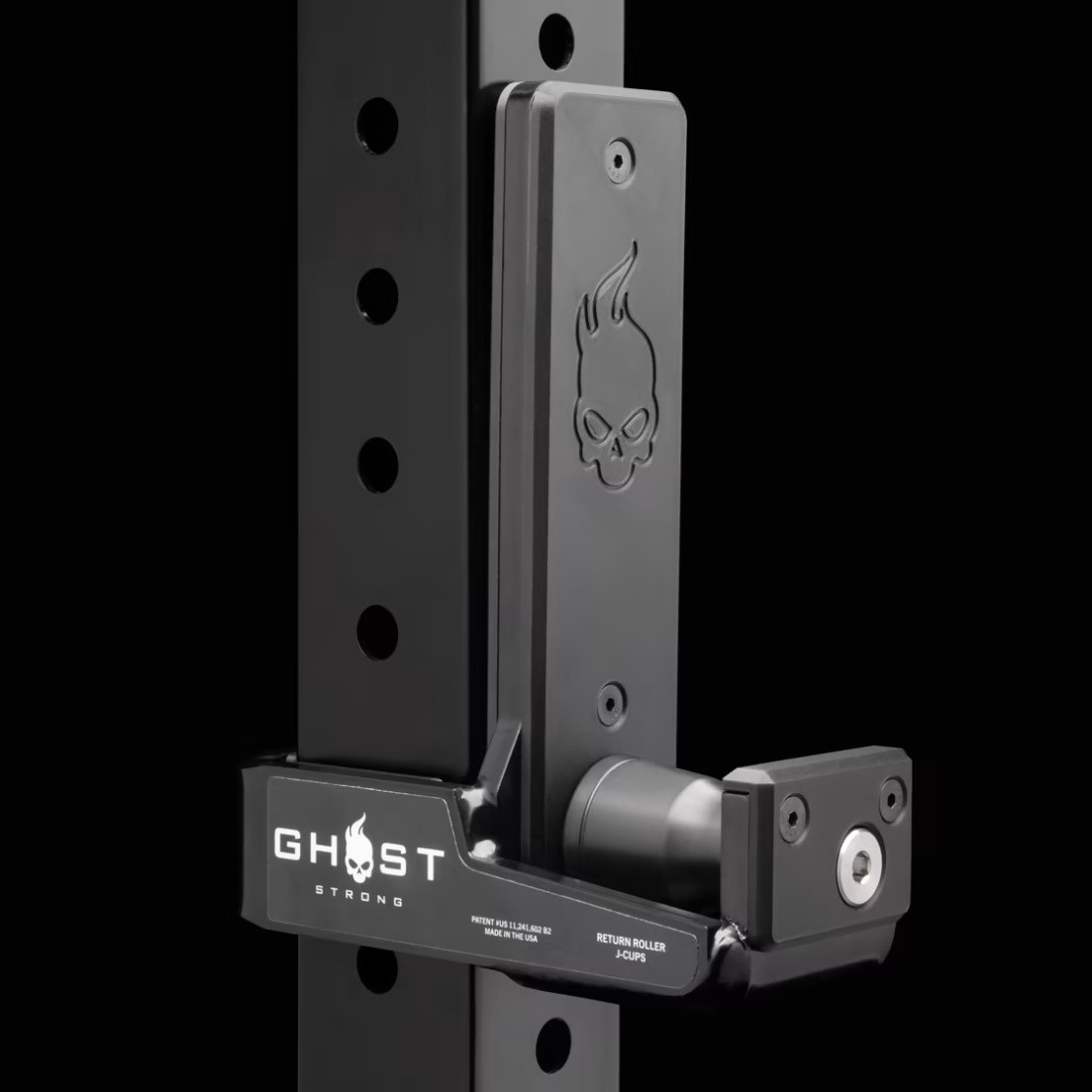
One more popular option I should mention is the Ghost Roller J Cups, which Rogue redesigned slightly (but keeping what made it popular) as version 2 when they acquired Ghost Strong’s IP in 2022, made in both a Monster Lite and Monster version.
Adapting for the Right Fit
I mentioned this in the section above on roller J-hooks, but this goes for all styles. Unlike some other power rack attachments, any J-hooks need to fit reasonably well on your rack. You don’t want significant slop when it comes to a safety-critical part like J-hooks that need to feel solid. This includes both the tubing size and the hole size being a good fit.
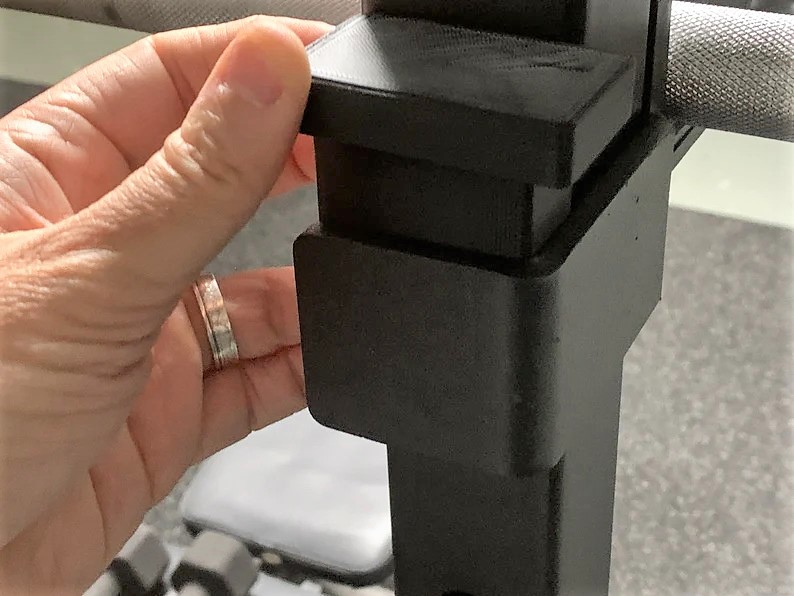
To make them fit good, an Etsy seller makes 3D printed J cup adapters made from PLA. His standard size of 2″ will let you fit a 2×3 J-cup on a 2×2 rack, while his standard size of 3″ will let you fit a 3×3 J cup on a 2×3 rack. It looks like he’s now making them in any custom size you need. Are they safe? I don’t know. You could probably epoxy it onto the bracket for some extra safety. He’s been selling them for some time now with good reviews.
Before those came out, I also suggested cutting some shims from UHMW plastic sheets with a power tool as a possible way to fit oversized J-hooks on smaller tubing, and maybe epoxy them on.

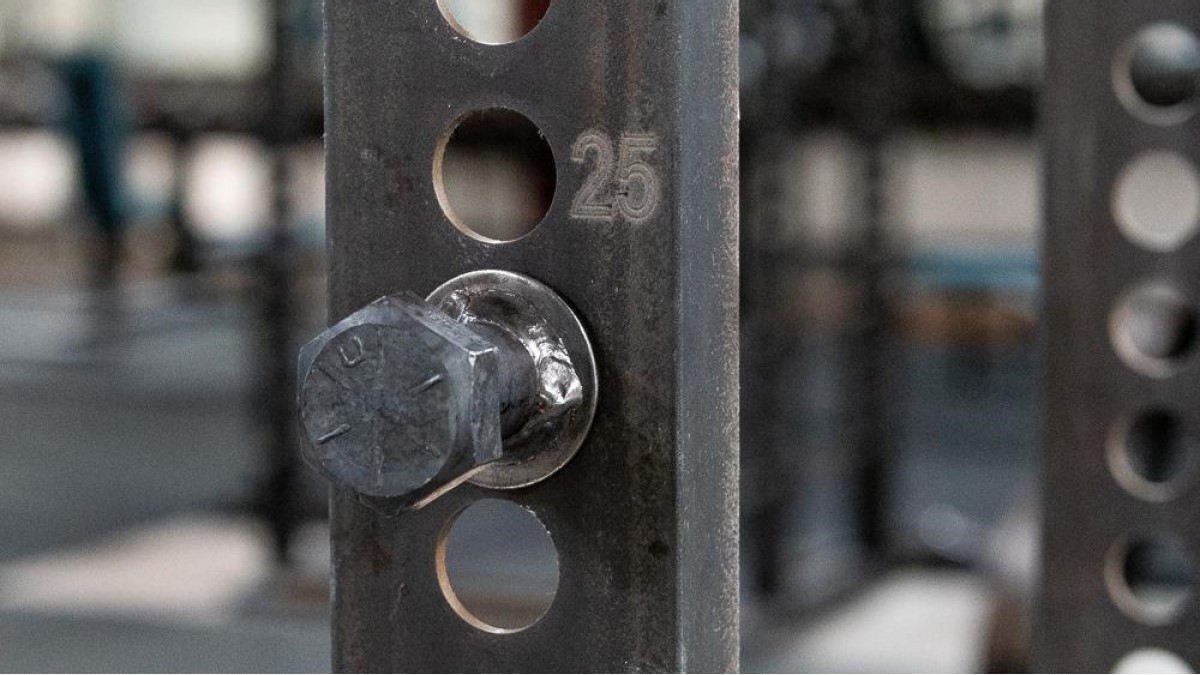
What would happen if you used a j-hook .5” pin in a power rack with a .8” hole?
It would probably be okay. That’s not a huge difference. A little more rattle, and it could potentially dip forward a little, depending on how snug the J-hook brackets are around the rack uprights. As long as you wiggle it around first to confirm that your bar isn’t in any more danger of falling off or knocking the J-hooks out of place somehow. Using the safety pins, if so equipped, might be a good idea.
So i’m struggling to find a barbell storage option that can hold a barbell on the top-most post (up and out of the way) and i can then pull down for doing squats in the rack. It’s a pita getting in and out of the rack for me (eventually going to hit a wall or mirror). i don’t want to use a set of j-cups just for storage (but that’s what i’m doing now and then i move them to the correct position). i was looking for something cheap like the attached. those are $50 which is the right price for me but they haven’t been in stock in over a year. this is for a 3×3 rep pr-5000, so ‘1-inch’ holes. I saw a picture of a rack with some hooks hanging from the top posts and that might work, but i don’t know who makes those. any thoughts here?
Some combination like this of bolts, nuts, washers and sleeves should do the job.
that looks pretty functional! for some reason, i got it stuck in my head that i needed to buy something lol. thanks!
i found these on amazon. these are for a body solid gpr 378, which is supposedly a 3×3 11-guage rack. i’ll let you know how they work! it ended up being about the same price as a set of nuts/bolts
well unfortunately, these do not fit a Rep FT-5000. the peg on these lift-offs is just too big to fit into the rack. The ID of the hole on the rack is 1-1/16″ while the OD of the peg is 1-3/16″.
ok went to Rural King and bought a pair of hitch pins ($9×2), shaft collars ($4×2), washers ($2.50*2), and two PVC sleeves ($.50×2). turned out pretty good I think! Thanks David!
Congrats on getting it sorted! Looks good.
Is there such a thing as a longer J Hook? My new squat rack doesn’t have holes all the way to the base like like my old one. I’m unable to use my hip thrust pad bc it’s too tall.
Curious what the use case is for getting “rounded j cups” vs. “flat j cups”.. (thinking rep fitness).
Great question. Traditionally J cups are the flat style, where you can walk the bar pretty close to the uprights and set it straight down. After racking you usually have to turn one end of the bar against the plastic, digging into it, to roll that side to be even front-to-back with the other end of the bar, or else roll the bar towards the lip of the cup to get in a better lift-off position for bench press. The rounded J cups solve this by forcing the bar into the saddle and it’s ready to go right away. Downside of the rounded is it makes racking the bar more touchy, the way you kind of have to walk it into the back and let it roll down. The rounded are probably sweeter if you have them set at the perfect height.
I should add some notes on this in the article.
Awesome thank you! Is there an exercise where you you would lean more to the flat? (bench, squat). Amazing site by the way, helped immensely in building my rig.
I’m not sure. I think I’d have to try the rounded and see how it feels.
I’m looking to upgrade my j hooks but my rack does not have any holes to attach a traditional j hook. The holes are on the sides of the rack only. Any ideas on where I can find some that’ll fit my rack? The rack itself doesn’t have any brand either. I’ve tried looking on google but I can seem to find anything.
Thank you in advance.
I find it funny that budget racks typically 2×2 uprights use 1″ pins on the j hooks vs 5/8″ pin on more expensive racks. A 1″ pin is much more reassuring than 5/8″ in my opinion.
My only concern would be a bad weld, on any size pin. I don’t think I’ve ever seen one bend. I don’t know why so many of those 2×2 racks use 1″ pins. I suspect it is (or was) actually cheaper for some reason.
A WORD OF CAUTION – I purchased several of Rep’s accessories for my Rogue Monster Lite rack, that fit the REP PR-4000, that DO NOT FIT the Rogue rack. The UHMW plastic which surrounds the rack (as part of the accessory) is too thick, and scraped paint off the rack. Although I purchased Rep’s J-hooks and not Rep’s “sandwhich J-cups,” I cannot envision the tolerances being any different. The Rep rep (lol) warned me ahead of time that the company does not guarantee fit – you are responsible for shipping these heavy items back, and possibly incurring a restocking fee.
Good feedback! That’s what I like to hear so I can edit things for accuracy. What else from Rep didn’t fit right besides the standard J cups? How long ago did you buy them?
UPDATE – although most of the REP accessories I received for my Rogue Monster Lite rack were a little too snug for the Rogue rack,and in a few instances caused the paint to be completely removed from my rack, I discovered that removal of one of the UHMW panels via an allen screw which holds them in place allowed me to easily use the Rep accessories without any advserse affects (wobbly or noisy due to it being looser). I love the price of the Rep accessories vs. Rogue, but you do get what you pay for – the Rep accessories I received were made in China, and are not as well-built as Rogue accessories. In addition, the Rep accessories are not packaged well for shipment, in a few cases came damaged, and any customer service issues have to go through email. On the other hand, I found Rogue to not be accommodating to an issue I had, so I will not buy anything from them unless I absolutely have to. So…I look around at other companies before I buy from either one now.
Good read, thanks David. Interesting that people used to just use bolts.
What ever they had lying around, I guess!
Great article! I can’t seem to find an answer to one question. My rack has 2 inch spacing in between holes. It’s causing issues. I had the thought that shouldn’t there be a j hook that hangs perfectly one inch below a hole to make all rack one inch spacing? Is this how any of them work? How can I figure this out? I’d very much appreciate any help! Thank you!
I don’t think I understand your question. The hole spacing is the distance between the hole centers on the rack uprights. Where the bottom of the J-hook is doesn’t really matter. Most J-hook attachments only use one hole, so the hole spacing doesn’t matter for them other than the example Titan roller J-hooks shown above that use a hitch pin hole that isn’t strictly necessary. Can you clarify?
That said, most manufacturers are going with a standard 2″ hole spacing. Unfortunately some say it’s 2″ spacing but they are done in metric and are off from the imperial 2″ just enough to not be compatible.
Rep makes a J-hook package that includes two sets of j-hooks, one hangs down two inches and one hangs down one inch. This gives you westside spacing options with the two inch spacing on your rack. I know it’s an option if you buy a full 5000 series rack but they may sell it by itself if you contact them.
I primarily use sandwich J-cups, but since my Rogue rack also came with a pair of standard lined J-cups I found the following product from Aperture Engineering to give additional protection to the front end. I don’t think it’s as strong as the UHMW, but it gives front lip protection. I’ve had it for a few months and thus far it has held up very well.
https://shop.apertureengineeringllc.com/products/rogue-monster-monster-lite-j-cup-protection
Those look pretty useful. I’ll have to email them and find out what kind of 3d printed plastic they use. I assume the bar knurling would wear it down quicker than UHMW, if you ever grind the knurling against it when twisting the bar to re-center.
Cary, I just noticed you’re the one that originally mentioned those J cup protectors to me and I forgot how I found them. I did a review on them last month. I’ll update it to give you credit!
https://www.tworepcave.com/14647/j-cup-protectors-review/
Love this article! I was DIY-ing one of the j cups putting a heavy duty plastic like that is really cool? How are those UHMW connected to the metal though? Are those flat head Allen screws or bolts connecting the UHMW and the actual j cup metal?
Right, the ones I’ve seen have the plastic mounted on with flathead allen screws, recessed in pretty good.
I have a Fringe Sport Rack. While the bottoms of the j cup is protected the curl is not. I took an old mountain bike tire tube and cut about a 2 1/2” sleeve and slid it over the j cup. Nice tight fit so it won’t move and everything is protected.
Nice! The rubber is good in a pinch. It is likely to wear down eventually. UHMW is pretty hard and even that eventually wears down against the bar knurling from the user repeatedly repositioning the bar.
Why do we care so much about ruining knurling in an area of the bar where we won’t use it?
It’s worth noting that people used unprotected steel J-hooks for decades and scratched up bars without concern. I think it started becoming more of an issue with olympic weightlifting getting a resurgence. A wide snatch grip might be right where the knurling is flattened. More home users are buying expensive bars than they did years ago too, and they don’t want to destroy the resale value of a new Rogue bar. Personally I don’t do snatches and have been fine using a slightly defective bar that I don’t care about, and I still like the UHMW liners because they cut the noise way down.
This is a good reply.
It’s probably much more practical for coated bars. Chrome, Cerakote, etc. The rust at the underlying level will lead to chipping (at least for crappy chrome bars).
Yeah good point, I guess in a humid climate that is an issue to watch out for. But then if it has no coating (bare steel) it’s even worse. Stainless is a good though!
Why the big deal about ruining the knurling on your bar at the extreme end closest to the collar? The only lifts where you would grip the bar that wide might be olympic lifts if even then and gripping the bar that far out would put you at risk for pinching your hand between the hook and the bar. Of course you could avoid this hazard by always having a spotter or using a monolift. Knurling at those ends is superfluous. It merely adds to the aesthetics of the bar and the cost. Man up if you are lifting iron to build strength or muscle avoid all these plastic add on and costly equipment upgrades. Its the equivalent of using bumper plates for bench pressing. The sound of iron hitting iron is part of the sport. If you work alone the most important part of the j-hook or j-cup is the depth. The depth needs to be such that you don’t have to press the bar up and out but not too shallow which would allow the bar to roll off the hook.